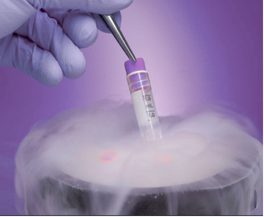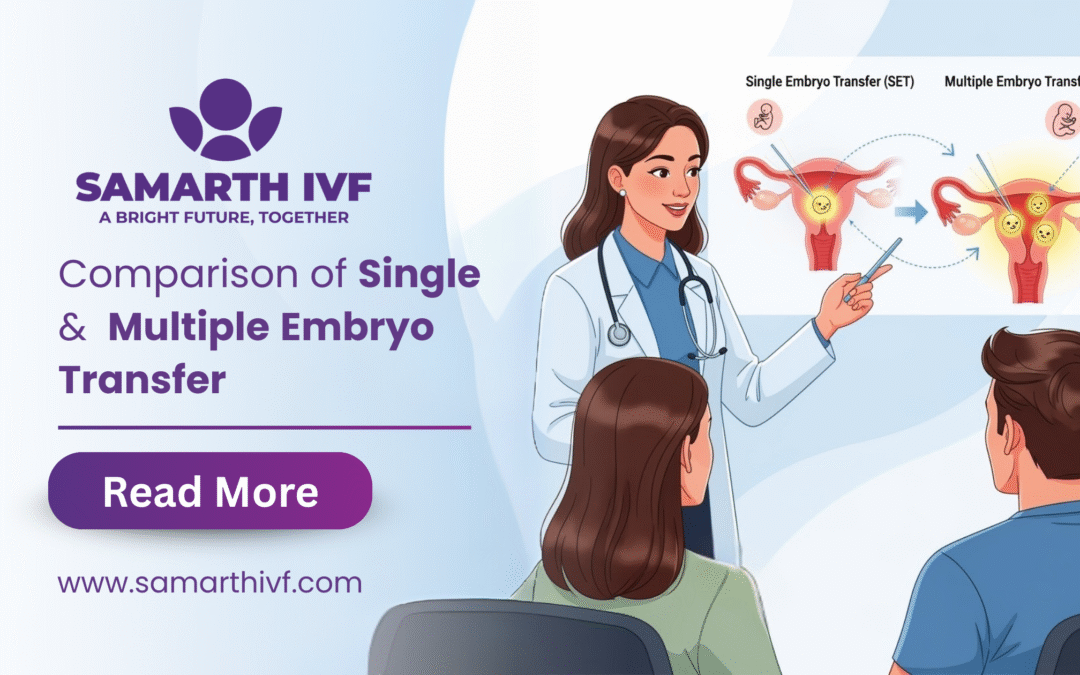Navigating the Most Critical Decision in IVF: A Comparison of Single and
Multiple Embryo Transfer
The journey through in vitro fertilization (IVF) is often characterized by a series of deeply personal and emotionally charged decisions. Among the most critical is the choice of how many embryos to transfer, a decision that carries profound implications for the health of the prospective parent, the baby, and the entire family unit. This report provides a comprehensive, data-driven analysis of single embryo transfer (SET) versus multiple embryo transfer (MET), moving beyond a simple medical debate to encompass the financial and psychological dimensions of this pivotal choice. The objective is to provide a clear understanding of the modern standard of care and to empower individuals with the knowledge necessary for a truly informed and shared decision-making process with their healthcare providers.
An Overview of Embryo Transfer and Its Evolution.
Defining the Procedures
In the context of modern fertility treatment, embryo transfer refers to the procedure where a fertilized egg, or embryo, is implanted into the uterus to establish a pregnancy. The number of embryos transferred is a key variable with significant implications.
• Single Embryo Transfer (SET): This procedure involves the implantation of a single embryo into the uterus. This approach is increasingly favored by fertility specialists as it directly addresses the primary risks associated with multiple pregnancies, prioritizing the health and safety of both the parent and the baby. An elective single embryo transfer (eSET) is a specific type of SET where a patient chooses to transfer a single embryo even when multiple high-quality embryos are available.
• Multiple Embryo Transfer (MET): This involves the simultaneous implantation of two or more embryos. Historically, this method was widely used to increase the likelihood of achieving a pregnancy within a single cycle, but its use has declined dramatically as the associated risks have become more apparent.
The Historical Context: The Necessity of Multiples
The evolution of embryo transfer is a narrative of remarkable scientific progress. The first successful human embryo transfer was a landmark achievement in 1984, following the birth of the first IVF baby in 1978. In the early days of assisted reproductive technology (ART), implantation and success rates were low, making the practice of transferring multiple embryos a logical and necessary strategy. The primary goal was to maximize the chance of a pregnancy per cycle, and the higher-order pregnancies that often resulted were an accepted consequence of a still-developing technology. At the time, this approach was seen as a justifiable means of increasing the odds of a live birth in what was still considered an experimental treatment.

The Paradigm Shift: Prioritizing Safety Through SET

Your content goes here. Edit or remove this text inline or in the module Content settings. You can also style every aspect of this content in the module Design settings and even apply custom CSS to this text in the module Advanced settings.
Your content goes here. Edit or remove this text inline or in the module Content settings. You can also style every aspect of this content in the module Design settings and even apply custom CSS to this text in the module Advanced settings.
This shift was made possible by critical technological advancements. The development of advanced cryopreservation facilities, which allow for the successful freezing and thawing of embryos, meant that excess embryos could be safely stored for later use, enabling the “one plus one” strategy of an initial SET followed by a subsequent frozen embryo transfer if needed. Additionally, the advent of preimplantation genetic testing for aneuploidy (PGT-A) and blastocyst culture and transfer has allowed clinicians to better identify and select the single, highest-quality embryo for transfer, eliminating the need to transfer multiple embryos in hopes that one will be viable.
The Core Comparison: Risks, Costs, and Psychology
The Disproportionate Medical Risks of Multiple Pregnancy
The most compelling argument for SET is the undeniable reduction in the medical risks associated with multiple pregnancies. While a multiple birth may be a “double blessing” for some, the medical reality is that carrying more than one fetus significantly increases the risk of severe complications for both the mother and the babies.
- Risks to the Mother: Women carrying multiples are at a significantly higher risk for a range of severe pregnancy-related conditions. These include preeclampsia, gestational hypertension, and gestational diabetes, which often appear earlier and are more severe than in singleton pregnancies. The likelihood of a Cesarean section is also significantly higher, as is the risk of postpartum hemorrhage.
- Risks to the Babies: The risks to the fetuses are particularly acute. The most significant concern is preterm birth, defined as birth before 37 weeks gestation. Data shows that over 60% of twins and nearly all higher-order multiples are born prematurely, and the risk of early birth increases with the number of fetuses. Prematurity is the root cause of a cascade of potential health issues, including respiratory distress syndrome due to undeveloped lungs, intraventricular hemorrhage (bleeding in the brain), and a high probability of extended care in a neonatal intensive care unit (NICU). The long-term health consequences can be devastating, including a higher risk of cerebral palsy, learning difficulties, chronic respiratory conditions, and other developmental delays. Conditions unique to multiple pregnancies, such as Twin-to-Twin Transfusion Syndrome (TTTS), which affects identical twins sharing a placenta, also pose grave risks.
The Financial Reality: Comparing a Price Tag to a Lifelong Investment
The financial conversation around SET and MET is often oversimplified. Patients may be tempted by the perceived cost savings of a single MET cycle, but a more thorough analysis reveals that this perspective is shortsighted. The cost of a fresh embryo transfer is typically included in the base cost of an IVF cycle, while a subsequent frozen embryo transfer (FET) costs an additional $3,000 to $5,000. While this may seem like an added expense, it is a minor one when compared to the potential costs of a complicated multiple pregnancy.
The medical risks of a multiple pregnancy directly translate into astronomical financial burdens. A prolonged NICU stay for a preterm infant can cost tens of thousands of dollars, and the potential for lifelong medical care, specialized therapies, and educational support for a child with developmental delays or chronic conditions represents a financial liability that far outweighs the cost of a few additional frozen transfers.

The decision to pursue MET to “save money” or to “get a baby faster” carries a significant financial risk, as a successful but complicated multiple pregnancy can lead to financial ruin. Conversely, the SET approach, while potentially requiring an additional transfer, limits the financial risk by almost eliminating the threat of a high-cost, high-complication multiple birth.
The Psychological and Emotional Toll
The emotional journey of IVF is a rollercoaster of hope and disappointment, and the choice between SET and MET introduces a unique psychological dynamic. Patients often choose MET to “get it over with” and avoid the emotional distress and anxiety associated with the potential of a failed cycle and the need to repeat a transfer. However, this decision can be a “psychological trap,” where the high expectations of a “double blessing” can lead to profound disappointment and trauma if the reality involves medical complications and a high-risk birth.

The psychological consequences of an unsuccessful cycle are well-documented, with nearly 70% of couples experiencing emotional distress after multiple IVF failures. A failed MET cycle, however, can be more emotionally devastating than a failed SET cycle. A failed MET is a “failure with two or more embryos,” which can intensify feelings of self-blame, guilt, and a profound sense of loss.
In contrast, a failed SET cycle leaves the patient with the hope and option of a subsequent frozen transfer, mitigating the finality and emotional devastation often associated with a full-cycle failure. The patient’s perception of “patient fatigue” from multiple transfers can, in fact, be a miscalculation, as the emotional toll of a single, failed MET cycle can be far more acute and difficult to recover from in the long run.
Dissecting the Data on Success Rates
Per-Cycle vs. Cumulative Success Rates: A Foundational Concept
To properly evaluate the success of SET and MET, it is essential to distinguish between per-cycle success and cumulative success. Per-cycle success refers to the outcome of a single embryo transfer, while cumulative success refers to the total outcome after all available embryos from a single egg retrieval have been transferred, including subsequent frozen transfers. While MET may yield a slightly higher per-cycle pregnancy rate, studies consistently show that the cumulative live birth rate for SET, which includes subsequent frozen embryo transfers, is comparable to that of MET.
How Patient Age and Embryo Quality Influence Outcomes
The most critical variable in determining success is not the quantity of embryos, but their quality. This is powerfully demonstrated by the data on age and the use of genetic testing. As a woman’s age increases, the chance of a successful live birth declines, regardless of the number of embryos transferred.
The following table synthesizes data from various sources to illustrate how embryo status and patient age affect live birth rates, demonstrating the pivotal role of embryo quality
| Embryo Status & Age Group | Clinical Pregnancy Rate (PGT-A Tested) | Live Birth Rate (General/Untested) |
| SET | ||
| All Ages | 61.70% | N/A |
| Under 35 | 61.00% | 41% |
| 35–37 | 68.80% | 30% |
| 38–40 | 58.60% | 20% |
| MET | ||
| All Ages | 77.60% | N/A |
| Under 35 | 80.00% | N/A |
| 35–37 | 83.30% | N/A |
| 38–40 | 65.20% | N/A |
The data clearly indicates that a single PGT-A tested embryo has an exceptionally high clinical pregnancy rate (70.6% overall) and a live birth rate of approximately 69%. One study even found that the success rate for a single PGT-A tested embryo was comparable to that of transferring multiple non-tested embryos across a wide age range. This demonstrates that the high per-cycle success of MET is often a “numbers game,” where transferring multiple embryos increases the odds of a single viable embryo implanting. The advent of PGT-A testing has made this strategy largely obsolete, as it allows for the identification and transfer of a single, genetically normal embryo, making MET an unnecessary and high-risk procedure.
The Path to an Informed Decision
• Patient Profile: A patient’s age, previous IVF history, and overall health are critical factors in determining the best approach.
• Embryo Quality: Patients should inquire whether PGT-A testing has been performed on their embryos and what their grading is. A high-quality, genetically normal embryo may make a strong case for SET.
• Number of Embryos Available: The presence of high-quality frozen embryos available for a subsequent transfer provides a significant buffer against the risk of a failed first cycle.
• Personal Risk Tolerance: The final decision is a deeply personal one. Patients must weigh their own comfort with the medical, financial, and psychological risks associated with each option.
Conclusion: The Modern Standard of Care
While multiple embryo transfer was once a justifiable practice in the nascent years of IVF, modern reproductive medicine, backed by robust data, has established elective single embryo transfer as the safest and most effective strategy for achieving a healthy singleton pregnancy in the majority of cases. The perceived benefit of MET—a slightly higher per-cycle success rate—is a dangerous illusion, outweighed by the significant and well-documented medical, financial, and psychological risks and costs.
The ultimate measure of success in fertility treatment is not a positive pregnancy test, but a healthy live birth. By choosing SET, patients and clinicians prioritize the long-term well-being of the future family over the immediate gratification of a higher per-cycle success rate. The modern standard of care is clear: the path to a healthy live birth is one of safety, patience, and a steadfast commitment to the highest quality medical practice.
